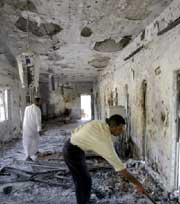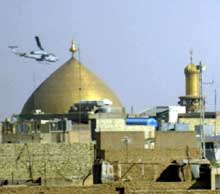|
Mosque Hit in Kufa, Ceasefire Expected in Najaf
 |
|
Over 100 were wounded when two mortar bombs fell on the Kufa mosque (AFP)
|
KUFA,
August 26 (IslamOnline.net & News Agencies) – At least 25 people
were killed Thursday, August 26, in a mortar attack on the main mosque
in Kufa, as Najaf governor said a 24-hour-long ceasefire was expected
later Thursday to coincide with the arrival of the most influential
religious Iraqi leader in the war-torn holy city, in a bid to end the
three-week crisis.
At
least 27 people were killed and more than 100 wounded when two mortar
bombs fell on Kufa's main mosque compound, Agence France-Presse (AFP)
reported.
The
Iraqi interim Interior Ministry said 60 people had been wounded in
Kufa, where hundreds of supporters of Shiite leader Muqtada Sadr were
in the mosque when the mortar hit.
Television
pictures showed dozens of wounded men lying on the ground amid pools
of blood or being ferried to Kufa's hospital. Survivors chanted angry
slogans.
The
US troops in Iraq, for their part, denied any involvement with the
bloody attack on the mosque.
This
came not long before two people were killed and dozens wounded when
Iraqi national guardsmen opened fire on a demonstration in support of
Sadr in Kufa, a photographer of AFP said he had witnessed.
Thousands
of people chanting their solidarity with Sadr and denouncing Iraqi
interim Prime Minister Iyad Allawi, were heading for nearby Najaf,
where Sadr's Mehdi Army is fighting US and Iraqi government forces.
They
were passing a military base on the road between Kufa and its twin
city of Najaf, when the national guardsmen opened fire at them, the
photographer said.
Thousands
of Iraqis began gathering in Shiite areas overnight to begin the
journey to Najaf, heeding a plea
by Iraq’s top Shiite scholar Grand Ayatollah Ali Al-Sistani
Wednesday, August 25, to save the city and end the US siege on its
holiest shrine.
Najaf
Ceasefire
In
Najaf, the governor said a 24-hour ceasefire would be declared in
Najaf upon the arrival of Ayatollah Al-Sistani, expected later
Thursday.
"The
government has decided to decree a 24-hour ceasefire from Sistani's
arrival in Najaf and to secure a protected route between Moqtada
Sadr's office and Sistani's to facilitate talks," Adnan Al-Zorfi
told reporters.
Zorfi
said US-led Iraqi government troops would stick to their positions
until an agreement was reached, adding that Sadr's militiamen must
disarm and leave the Imam Ali mausoleum - their military headquarters.
"If
there is no agreement after 24 hours, the fighting will resume,"
he said.
The
ceasefire was agreed during talks between Iraqi government ministers
and Sistani at a villa in Basra late Wednesday, he added.
Sistani
left Iraq for medical treatment in London just as the Najaf uprising
began three weeks ago.
Dressed
in a black robe and turban, with a flowing white beard and dark rings
around his eyes, he made a dramatic return Wednesday, arriving from
Kuwait and spending the night in Basra.
His
followers say Sistani’s intervention could break the deadlock in
Najaf and ensure a peaceful resolution to a conflict that has driven
world oil prices to record highs and undermined the authority of
Allawi, according to Reuters.
He
will unveil a plan in Najaf to get the Mehdi militia out of the Imam
Ali mosque and call on US marines encircling Iraq's holiest Shiite
shrine to leave the city, his aides said.
But
amid fears of violence with rival Sadr supporters, he urged his
followers converging on Najaf to wait outside the city and get
instructions when he arrived, a senior aide said.
"On
his arrival, a (peace) initiative will be launched," Hamed
Al-Khafaf told Reuters.
Losing
Ground
 |
|
A US Cobra attack helicopter hovers above the shrine of Imam Ali (AFP)
|
Meanwhile,
a spokesman for the Mehdi Army admitted its militiamen have lost
control of significant parts of Najaf following the heavy US-led
attacks overnight.
"It's
not like before. The area we control has significantly shrunk. They
(the Americans) are trying to maintain their control on Najaf because
they have failed everywhere else in Iraq," Sheikh Ahmed
Al-Shaibani told AFP.
He
said six bodies and 20 people with injuries had been brought into the
makeshift clinic in the revered Imam Ali shrine in the last 24 hours.
On
the 21st day of fighting, US warplanes unleashed a fierce attack on
militiamen targets in Najaf overnight, just after US artillery fire
rattled the city which has a peacetime population of 500,000, about
100 miles south of Baghdad.
Witnesses
said heavy shooting and mortar bomb attacks also broke out near the
Najaf shrine Thursday.
Gunfire
later erupted away from the mosque, indicating fighting was taking
place elsewhere in the besieged city.
US
snipers were hunkered down on the rooftops of neighboring houses. A
dozen bullet holes were visible in the golden dome of the shrine, and
some of its 7,777 golden tiles had come loose, said an AFP
correspondent, one of three newsmen inside the shrine.
Several
missiles were fired from the air and tanks were still within 20 meters
(yards) of the western side of the mosque, Sadr's military
headquarters since his clashes with US occupation troops began.
All
entrances to the mosque were covered by elite US marksmen and it was
impossible to enter or leave the building, as the heavy thud of Mehdi
Army mortar fire resounded from inside the shrine.
Mosque
loudspeakers urged the militia to jihad as sanitary conditions
deteriorated in the mosque, effectively cut off by US troops in a
pincer-like grip since early Wednesday.
This
came one day after the senior aide of Shiite Muslim militia leader
Sadr, Sheikh Ali Smeisim, was arrested Wednesday in Najaf.
Iraqi
police said that Smeisim was detained along with four other
lieutenants of Sadr in the Al-Saad district near the 1920 Revolution
Square, said a senior police officer on condition of anonymity.
|